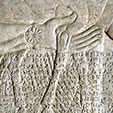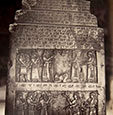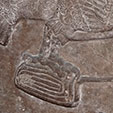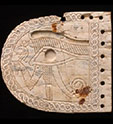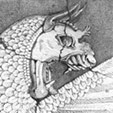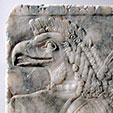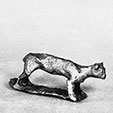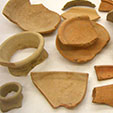Biographies of Nimrud objects
How did particular objects that were made or used in ancient Kalhu travel from the archaeological site at Nimrud to museum collections? And how were new ideas about them created, and by whom? This page tells the stories of selected objects now housed in UK museums.
The Standard Inscription of Assurnasirpal II
King Assurnasirpal II built a vast palace in his new capital city of Kalhu. The palace walls were lined with stone panels carved in low-relief TT depicting war, hunting and religious scenes. The same cuneiform TT inscription runs across many of the reliefs, telling of Assurnasirpal's victories and the founding of the city. This text is now known as the "Standard Inscription" of Assurnasirpal II. Reliefs inscribed with the Standard Inscription are scattered across many museums around the world, including the British Museum TT in London.
The Black Obelisk of Shalmaneser III
This two-metre high stone monument is inscribed with words and imagery celebrating the military successes of king Shalmaneser III. After its discovery in 1846, the Obelisk quickly became famous for containing the earliest depiction of a king of Israel PGP . It is now on display in the many museums around the world, including the British Museum TT in London.
The Succession Treaties of Esarhaddon
These treaties were drawn up in 672 BC by king Esarhaddon PGP in order to control his subjects. The treaties were designed to ensure that Esarhaddon's son Assurbanipal PGP would take the throne of Assyria after him. Everyone who signed the treaty was expected to protect the new king. Anyone breaking its oaths was threatened with horrible curses by the gods, including having their innards devoured by vultures. Copies of the treaty are spread across several museums, including the many museums around the world, including the British Museum TT in London.
The Nimrud ivories
The many thousands of beautiful ivory carvings from Nimrud have been alternately treasured and forgotten throughout their long history. Most were made by master craftsmen in the northeastern Mediterranean, then abandoned as surplus booty in the storerooms of Kalhu. Some were carved in Assyria itself and were an important element of luxury court living. In modern times, some have been plundered or forgotten again, while others are cherished as exquisite examples of ancient art in museums across the world.
Anzu the monstrous lion-eagle
The Anzu PGP bird was a mythical creature, half-lion, half-eagle. In 9th-century Kalhu, he was portrayed doing battle with the warrior god Ninurta, at an entrance to the most important shrine of the royal citadel. Layard PGP discovered this sculpture in the mid-19th century, and shipped it to the British Museum TT . For many generations this unnamed "dragon" or "demon" TT captivated the public imagination in many different ways. However, it took over half a century to rediscover Anzu's true identity.
The stone genies in the Northwest Palace
Sculptural elements from king Assurnasirpal II's Northwest Palace have ended up in museums and collections all over the world. Behind each sculpture is a story of creation, disappearance, rediscovery and reinterpretation - too many to tell one by one. Here we take the images of three different winged figures, now in the Fitzwilliam Museum, Cambridge, as case studies in the dispersal and re-evaluation of some of Nimrud's most striking finds.
The model dog that became a cat
Objects from 1950s excavations at Nimrud have been dispersed into museum collections across the world because of the way those excavations were funded. Museums gave financial donations to the digs in return for gifts of artefacts, and groups of similar objects were deliberately separated to give different museums a representative sample. What effects have separation and dispersal had on how Nimrud objects are understood? This article explores that question using the case study of a model figurine TT gifted to the Museum of Archaeology and Anthropology, Cambridge. The model began life in antiquity as a dog, but gained a new identity as a cat after its rediscovery.
Royal pots and broken pots
Pottery vessels in museum collections are usually complete or restored artefacts, which are appealing for display. The Museum of Archaeology and Anthropology in Cambridge (MAA) has many fine vessels from the royal residences of Kalhu, including wine cups from the Northwest Palace. But not all of MAA's Nimrud pots were collected with display in mind. Among them is a series of around 40 broken pottery pieces. This article explores why the museum collected broken pots, as a teaching tool for budding archaeologists.
